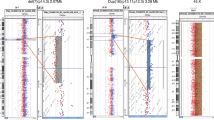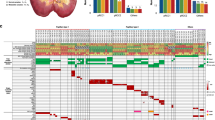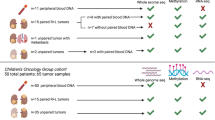Abstract
The gene defect for hereditary papillary renal carcinoma1 (HPRC) has recently been mapped to chromosome 7q, and germline mutations of MET (also known as c-met) at 7q31 have been detected in patients with HPRC (ref. 2). Tumours from these patients commonly show trisomy of chromosome 7 when analysed by cytogenetic studies and comparative genomic hybridization3 (CGH). However, the relationship between trisomy 7 and MET germline mutations is not clear. We studied 16 renal tumours from two patients with documented germline mutations in exon 16 of MET. Flourescent in situ hybridization (FISH) analysis showed trisomy 7 in all tumours. To determine whether the chromosome bearing the mutant or wild-type MET gene was duplicated, we performed duplex PCR and phosphoimage densitometry using polymorphic microsatellite markers D7S1801 and D7S1822, which were linked to the disease gene locus, and D1S1646 as an internal control. We determined the parental origin of chromosome alleles by genotyping parental DNA. In all 16 tumours there was an increased signal intensity (2:1 ratio) of the microsatellite allele from the chromosome bearing the mutant MET compared with the allele from the chromosome bearing the wild-type MET. Our study demonstrates a non-random duplication of the chromosome bearing the mutated MET in HPRC and implicates this event in tumorigenesis.
This is a preview of subscription content, access via your institution
Access options
Subscribe to this journal
Receive 12 print issues and online access
$209.00 per year
only $17.42 per issue
Buy this article
- Purchase on Springer Link
- Instant access to full article PDF
Prices may be subject to local taxes which are calculated during checkout




Similar content being viewed by others
References
Zbar, B. et al. Hereditary papillary renal carcinoma. J. Urol. 153, 907–912 (1995).
Schmidt, L. et al. Germline and somatic mutations in the tyrosine kinase domain of the MET proto-oncogene in papillary renal carcinomas. Nature Genet. 16, 68–73 ( 1997).
Kovacs, G. Molecular cytogenetics of renal tumours. Adv. Cancer Res. 62, 89–124 (1993).
Schmidt, L. et al. Two North American families with hereditary papillary renal carcinoma and identical novel mutations in the MET proto-oncogene. Cancer Res. 58, 1719–1722 (1998).
Rowley, J.D. Biological implications of consistent chromosome rearrangements in leukemia and lymphoma. Cancer Res. 44, 3159– 3168 (1984).
Bianchi, A.B., Aldaz, C.M. & Conti, C.J. Nonrandom duplication of the chromosome bearing a mutated Ha-ras-1 allele in mouse skin tumours. Proc. Natl Acad. Sci. USA 87, 6902-6906 ( 1990).
Bremner, R. & Balmain, A. Genetic changes in skin tumour progression: correlation between presence of a mutant ras gene and loss of heterozygosity on mouse chromosome 7. Cell 61, 407– 417 (1990).
Wirschubsky, Z., Wiener, F., Spira, J., Sümegi, J. & Klein, G. Triplication of one chromosome no. 15 with an altered c-myc containing EcoRI fragment and elimination of the normal homologue in a T-cell lymphoma line of AKR origin (TIKAUT). Int. J. Cancer 33, 477–481 ( 1984).
Jeffers, M. et al. Activating mutations for the MET tyrosine kinase receptor in human cancer. Proc. Natl Acad. Sci. USA 94, 11445–11450 (1997).
Knudson, A.G. Genetics of human cancer. Ann. Rev. Genet. 20, 231–251 (1986).
Pinkel, D. et al. Fluorescence in situ hybridization with human chromosome-specific libraries: detection of the trisomy 21 and translocations of chromosome 4. Proc. Natl Acad. Sci. USA 85, 9138– 914 (1988).
Author information
Authors and Affiliations
Corresponding author
Rights and permissions
About this article
Cite this article
Zhuang, Z., Park, WS., Pack, S. et al. Trisomy 7-harbouring non-random duplication of the mutant MET allele in hereditary papillary renal carcinomas. Nat Genet 20, 66–69 (1998). https://doi.org/10.1038/1727
Received:
Accepted:
Issue Date:
DOI: https://doi.org/10.1038/1727
This article is cited by
-
Clear cell and papillary renal cell carcinomas in hereditary papillary renal cell carcinoma (HPRCC) syndrome: a case report
Diagnostic Pathology (2021)
-
MET alterations in biphasic squamoid alveolar papillary renal cell carcinomas and clinicopathological features
Modern Pathology (2021)
-
Overexpression of the cohesin-core subunit SMC1A contributes to colorectal cancer development
Journal of Experimental & Clinical Cancer Research (2019)
-
Mutation, methylation, and gene expression profiles in dup(1q)-positive pediatric B-cell precursor acute lymphoblastic leukemia
Leukemia (2018)
-
The multiple paths towards MET receptor addiction in cancer
Oncogene (2018)



